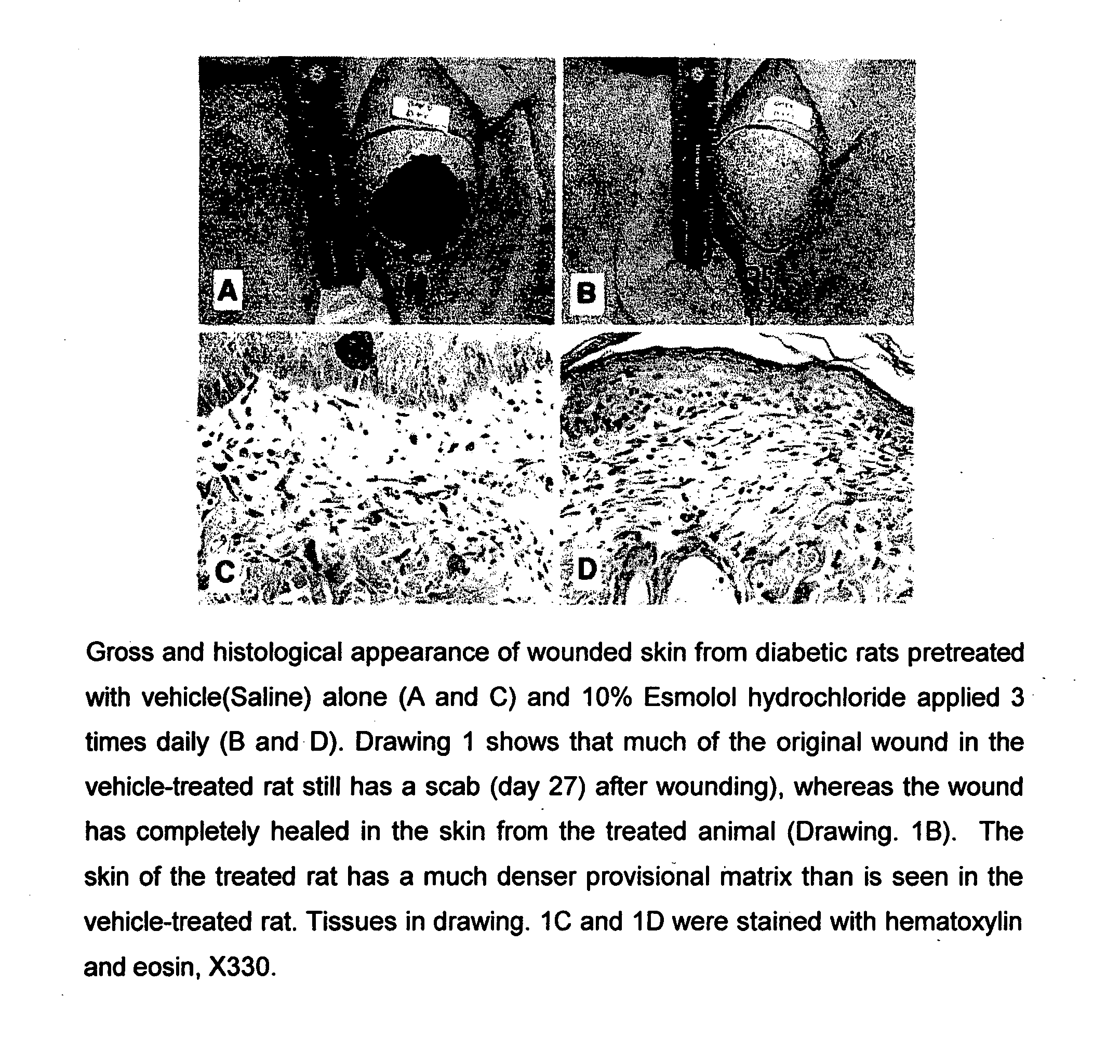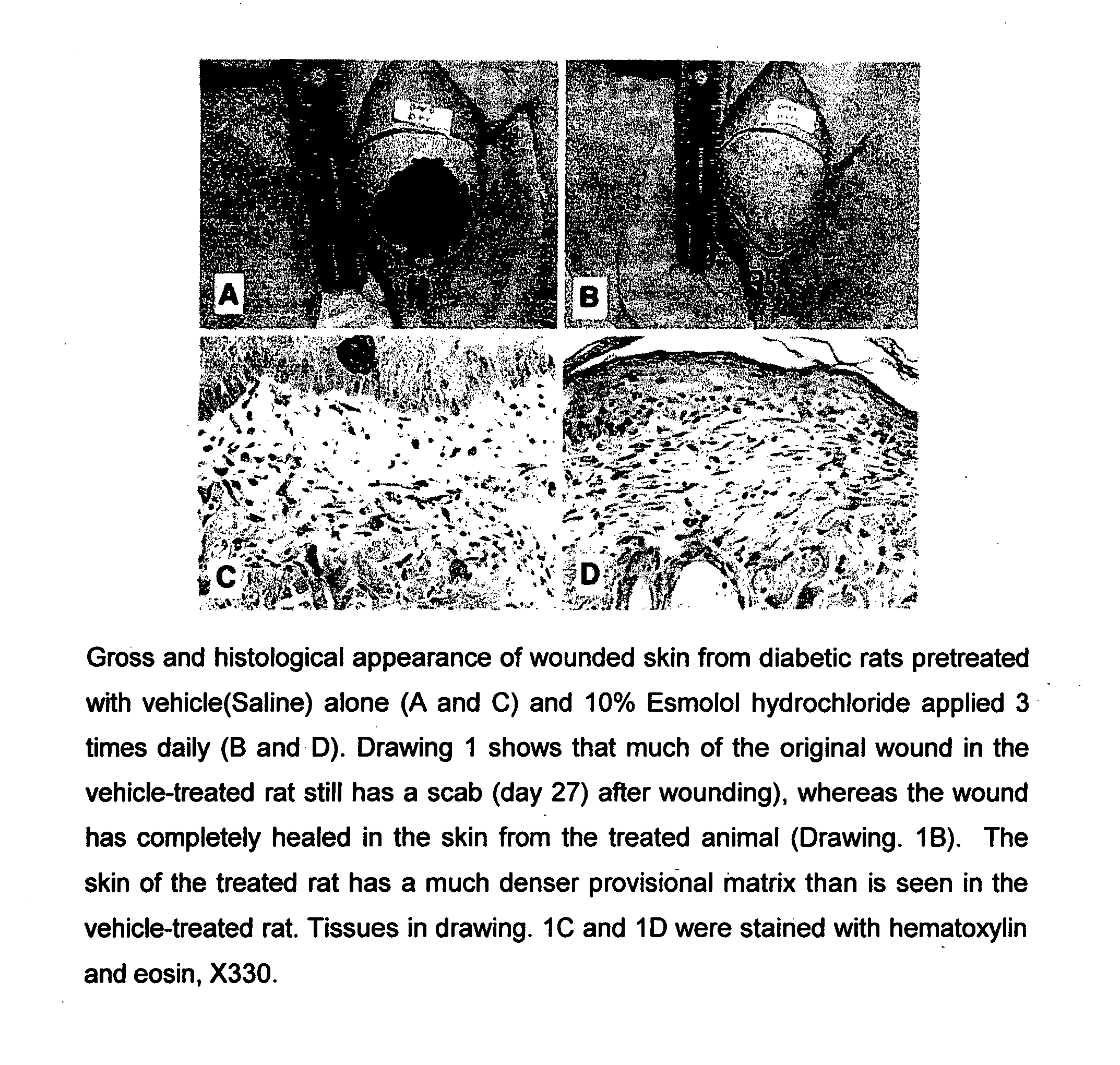Pharmaceutical Composition for Treatment of Diabetic Complications
a technology of diabetic complications and pharmaceutical compositions, applied in the field of pharmaceutical compositions for treating diabetic complications, can solve the problems of chronic ulcers, impaired wound healing, and standard anti-diabetic drugs that are not suitable for diabetic complications treatment options, and achieves the effects of facilitating fibroblast migration, reducing nitric oxide levels, and inhibiting enhanced aldose reductase activity
- Summary
- Abstract
- Description
- Claims
- Application Information
AI Technical Summary
Benefits of technology
Problems solved by technology
Method used
Image
Examples
example 1
Aldose Reductase (AR) Inhibition Studies:
[0066]For enzyme inhibition studies, purified human recombinant aldose reductase (expressed in E. coli) was used for testing the aldose reductase (AR) inhibitory activity of beta adrenergic antagonists by a spectrophotometric method, using glyceraldehydes as substrate, (Mol. Vis. 2004, 10, 148-154).
Materials:
[0067]DL-glyceraldehyde, glucose, lithium sulfate, 2-mercaptoethanol, NADPH, dimethylsulfoxide, TC-199 medium (M-3769), sorbitol, sorbitol dehydrogenase, NAD, and glutathione reductase were purchased from Sigma Chemical Company (St. Louis, Mo.). Beta-adrenergic antagonists including timolol, esmolol, sotalol, nebivolol, carvedilol, metoprolol and labetalol, used in the experiment were obtained as pure active pharmaceutical ingredients (APIs) from local commercial suppliers. The salts of beta antagonists used for the experiments are: timolol maleate, sotalol hydrochloride, labetalol hydrochloride, metoprolol tartrate, nebivolol hydrochlori...
example 2
Estimation of Sorbitol in Red Blood Cells
[0072]The compounds that showed effective aldose reductase inhibition (esmolol, timolol, propranolol) were tested for their potential to inhibit formation of sorbitol in red blood cells (RBC). The cells were incubated with 30 mM glucose in vitro. Sorbitol was estimated by the method of reported by Malone, et al. Diabetes; 1980; 29: 861-864.
TABLE 2Sorbitol concentration in RBCSr.SorbitolNo.Condition(μg / ml)1.RBC under normal conditions12.132.RBC under 30 mM glucose21.833.RBC under 30 mM glucose +16.16150 μM of esmolol4.RBC under 30 mM glucose +17.34250 μM of timolol5.RBC under 30 mM glucose +18.25350 μM of propranolol
example 3
Animal Experiments: Diabetic Wound Healing
[0073]Wistar rats were kept in standard autoclaved rodent cages with ad libitum food (Harland Tekland Irradiated Rodent Diet) and autoclaved water. The rats were housed on Harlan Tek-chip pelleted paper in static micro isolators maintained at 72° F., 60% humidity, and a 12 hour light cycle. The animals were kept at the facility for 10 days to get accustomed to the environment, after the arrival from the vendor. Diabetes was induced in the rats by intraperitoneal injection of 50 mg / kg body weight of streptozocin on 5 consecutive days. The wound was created on the rat by using a contortive scratcher to make a 2 mm incision with 0.57-0.62 mm depth on the dorsal skin of the animal. The area was shaved and sanitized with normal lugol's iodine prior to use of the scratcher.
Compound Administration and Wound Handling:
[0074]Esmolol hydrochloride (10%) was administered three times daily or the standard treatment control, by smearing the agent directly...
PUM
| Property | Measurement | Unit |
|---|---|---|
| pH | aaaaa | aaaaa |
| pH | aaaaa | aaaaa |
| humidity | aaaaa | aaaaa |
Abstract
Description
Claims
Application Information
 Login to View More
Login to View More - R&D
- Intellectual Property
- Life Sciences
- Materials
- Tech Scout
- Unparalleled Data Quality
- Higher Quality Content
- 60% Fewer Hallucinations
Browse by: Latest US Patents, China's latest patents, Technical Efficacy Thesaurus, Application Domain, Technology Topic, Popular Technical Reports.
© 2025 PatSnap. All rights reserved.Legal|Privacy policy|Modern Slavery Act Transparency Statement|Sitemap|About US| Contact US: help@patsnap.com



